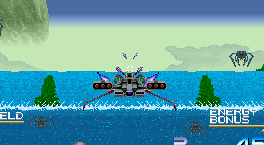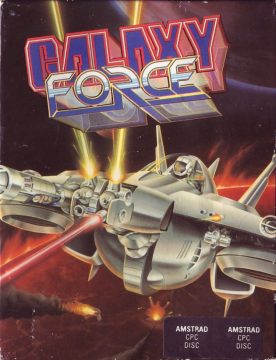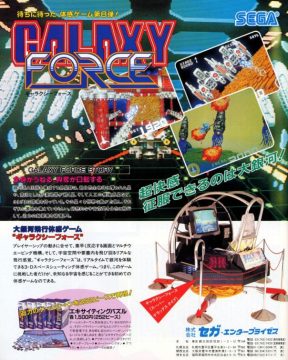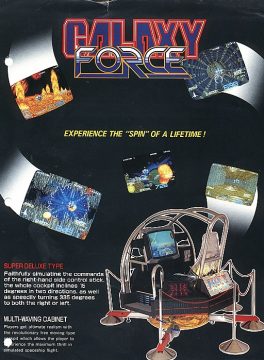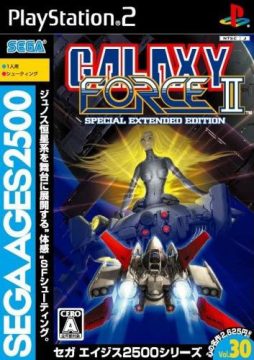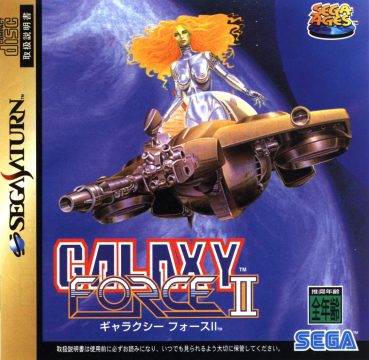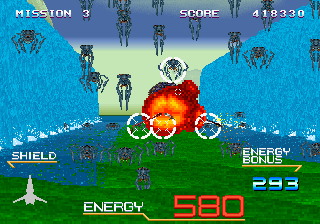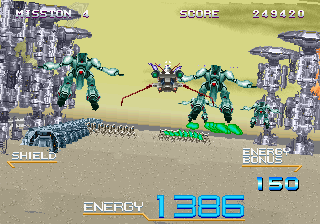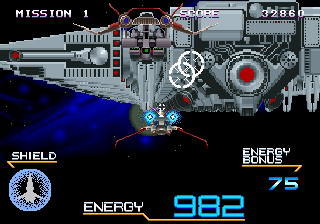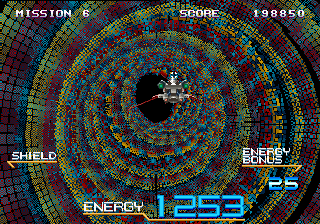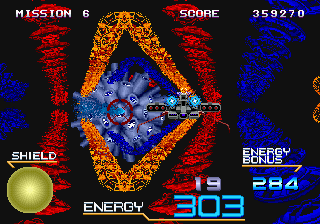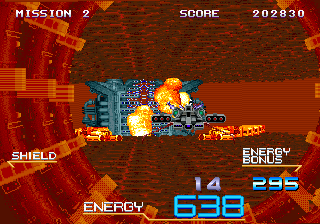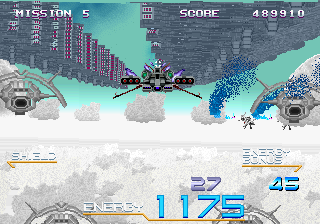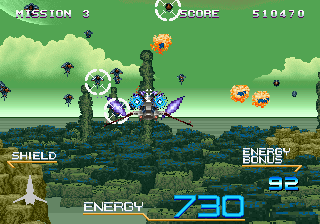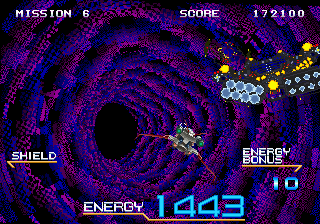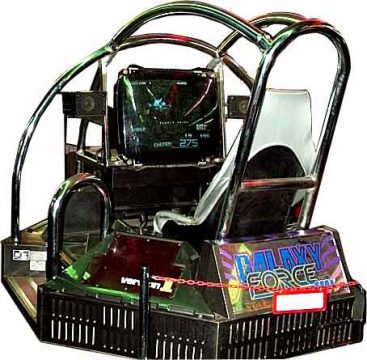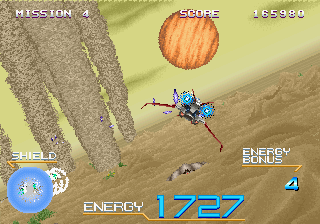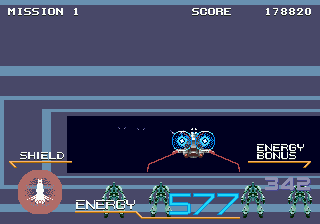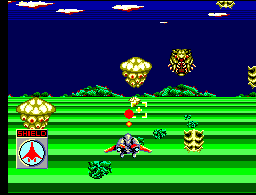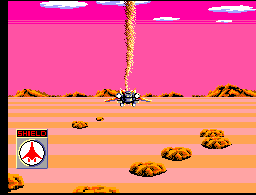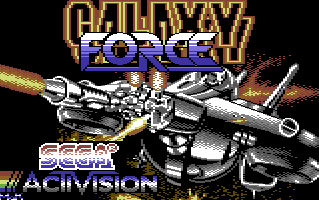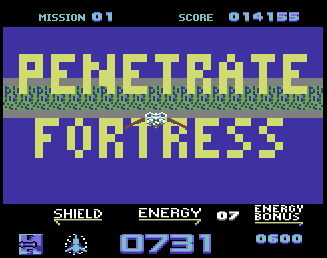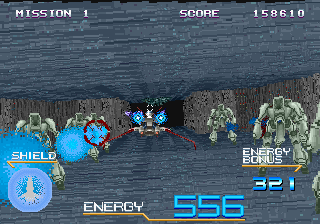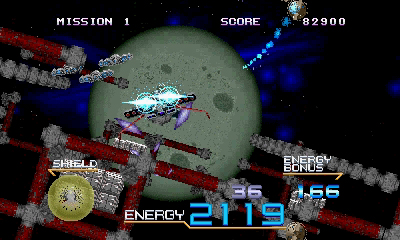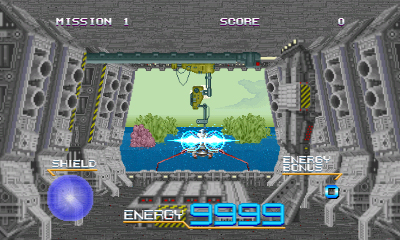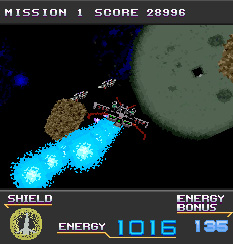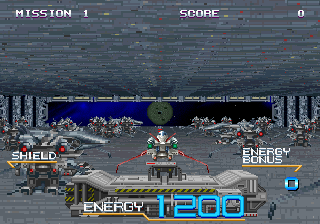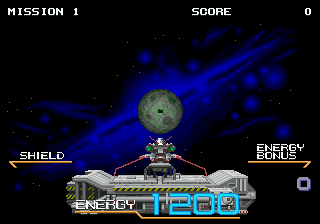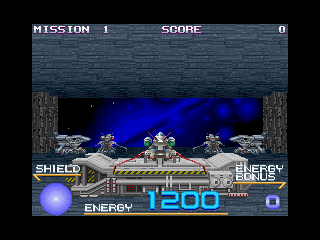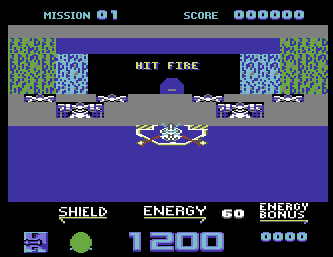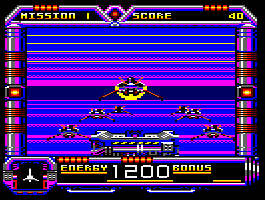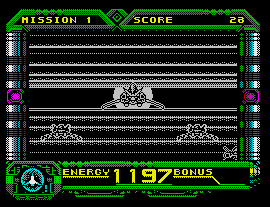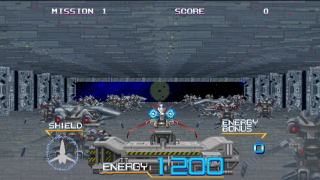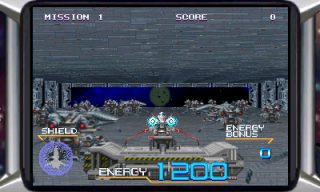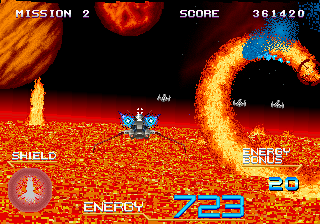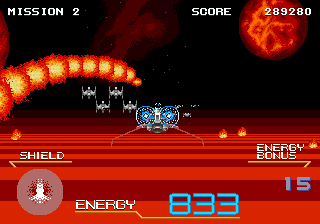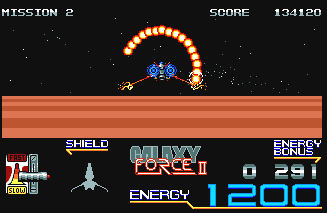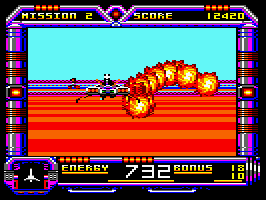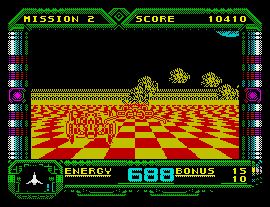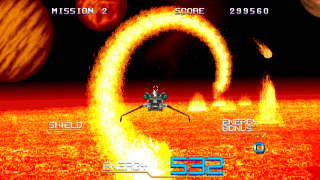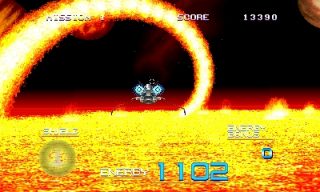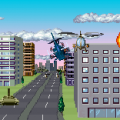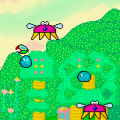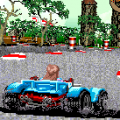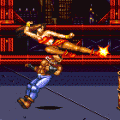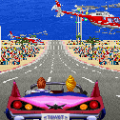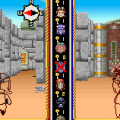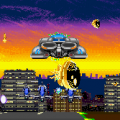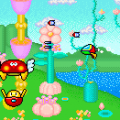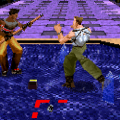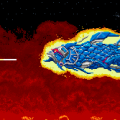Galaxy Force is the ultimate culmination of Sega’s “super scaler“ series, developed for their System Y board in 1988. While the practice of using 2D bitmaps to simulate 3D has long become passe, this game manages to impress even decades after its initial release.
Not only is Galaxy Force essentially “After Burner in space“, but it also bridges the gap between Sega’s older “super scaler“ games and later, fully 3D rail-shooters like Panzer Dragoon and Rez. Taking control of the spaceship Try-Z through six levels, as you fight against an organization known as The Fourth Empire, you have two primary weapons: a rapid fire Vulcan cannon of limited use, and much more powerful homing missiles, which can lock on to enemies if you target them with your cursor.
Beyond that are several other tweaks to the formula. In After Burner, your range of motion was limited to a fairly small box, but in Galaxy Force your movement is much less constrained. You’re still flying forward on a set of rails, but you can veer off the sides a bit, plus it’s much easier to dodge. It feels like you’re more involved with the piloting of the ship, instead of just watching scenery fly by. It’s also paced significantly slower, so it’s a fair bit less chaotic. The missiles work differently too, in that you can lock onto multiple enemies, and fire at them all at once. You also have an unlimited supply of missiles, making them the go-to weapon in most cases.
Rather than flying over largely empty expanses of terrain, there’s also a great focus on level design. Most stages are divided into two areas: an outside area, and an interior “fortress“ stage. In the latter you fly through caves and tunnels, an evolution of the canyon areas from After Burner. Each stage climaxes with a brief siege on a central core, which go down without any major fight. It’s clear from the first stage that Galaxy Force was heavily inspired by the final battle against the Death Star in Return of the Jedi.
There are other subtle Star Wars references too, which highlight how impressive this game looked, especially back in 1988. Shortly after you’re launched out of your carrier for the first mission, a gigantic, long length cruiser sneaks up from behind. Like everything else in the “super scaler“ universe, it’s just the same image stacked over itself multiple times, but due to some impressive visual trickery, it actually looks something like an Imperial Star Destroyer, albeit on a smaller scale. Similarly, when you fly through an asteroid field, the sprites are layered in a way that it actually looks like a fully 3D object, even though it isn’t.
The visual design, as you’d expect from Sega, never fails to impress. Each stage has a unique theme, ranging from the asteroid belt in the first stage, the lava and solar flares in the second, the jungles and waterfalls of the third, and the numerous devastating tornadoes of the forth. The final level also gets trippy, with tunnels featuring weaving expanses of color and other bits of visual craziness that are meant to represent hyperspace. The music, as expected of Sega, is quite classy. The melodies of most of the songs aren’t terribly notable, but they all have really awesome bass lines, courtesy of some very high quality guitar samples, which gives the soundtrack a funkier texture than most other Sega arcade games. It was composed by Funky K.H. (Katsuhiro Hayashi) and Pretty K.N. (Kouichi Namaki), who also worked on Thunder Blade, which has some similarities to this soundtrack.
You can choose which of the five planets to begin your sortie, although they play out in a determined order from there. After conquering all of them, you can play the sixth and final stage. There are no power-ups, except for an attachment which will automatically merge with your fighter partway through the stage, allowing you to shoot more missiles at once.
Galaxy Force’s biggest fault, more than most of Sega’s other arcade games, is that it presents itself more as an amusement ride than a game. Many of the company’s games featured cabinets that would sway back and forth as you pilot the ship, and Galaxy Force is no different. However, it is also much more transparent about milking as much money from the player as possible, due to the “ENERGY“ meter at the bottom of the screen. You begin with 1200 points, which quickly counts down from the moment you launch. Additionally, although you begin with a shield, it’ll disappear after a few hits, with all further damage deducting from the energy total.
There are ways to mitigate the loss: accelerating in order to reach the end quicker, or killing as many enemies as possible to get a higher energy bonus, rewarded at various points throughout the stages. But unless you play a nearly perfect game, the countdown is so quick that it’s incredibly difficult to recoup your losses, and the net result is a game that’s limited to a few minutes of play per credit. In the overseas release, you can easily continue from where you left off by pumping in more credits – at least, up until the last level – but the Japanese version forbids continuing at all. Regardless of this problem, and even divorced from the motion-control cabinet it was meant to be played in, Galaxy Force is still an incredibly impressive feat of programming, a work of art in its own way.
Most instances of the game are known as Galaxy Force II. Much like After Burner, the numeral indicates an enhanced version, rather than a true sequel – it’s more like Galaxy Force 2.0 than anything, thereby making the original version redundant. The first Galaxy Force was only on the market in Japan for two months before being superceded by this conversion kit. The number of levels was expanded from four to six, and each level was expanded and rebalanced. It also lets you fire all four missiles in a single button press, rather than firing individually like After Burner.
There are three different types of cabinet: a standard upright cabinet, and two full sit-down cabinets that tilt side-to-side, known as the Deluxe Edition and Super Deluxe Edition. They are mightily impressive, especially the Super Deluxe version, which could rotate up to 335 degrees left and right, and tip forwards and backwards at 15 degrees. The Super Deluxe cabinets also had headphone jacks so the player could get lost in the sights and sounds of Galaxy Force.
Alas, most games are likely to be more well known for their home ports rather than arcade originals, which tends to reflect badly on Galaxy Force. The System Y was simply far too powerful to be even remotely replicated on any console at the time, resulting in ports that were at best heavily compromised and at worst largely terrible. A major factor in all of the home versions though – since they’re naturally less dependent on squeezing money from the player – is that the energy drainage is not as quick, and you regain substantially more after each level.
For a long time the best version was the FM Towns computer release, which was also compatible with the Marty console. Both systems were only available in Japan. Ported by CRI, it looks and feels reasonably close to the arcade version, since the system was much more powerful than any other console at the time, but it’s not without some downgrades. It runs in a window that takes up about 75% of the screen, plus the action isn’t quite as smooth, often slowing down or causing sprite flickering. Some bits of detail have been scaled back too, like the number of robots found in the second part of the first stage, which has been greatly reduced. The branching paths in the tunnels are also gone. Still, it’s far better than the other versions at the time, and includes a redbook audio soundtrack with some cool remixed music.
CRI also developed the Genesis version, which is far more regrettable. The system couldn’t even replicate other “super scaler“ games like Space Harrier or OutRun, so what hope could it have for Galaxy Force II? Since the system doesn’t support sprite scaling, it instead uses a set of sprites, each drawn at specific distances, which is incredibly choppy in motion. Most of the obstacles and enemies have been removed. The tunnel stages are done entirely with rolling colors, and it looks really, really awful. Due to the lack of buttons, the guns are on auto-fire by default, with the remaining buttons used to control speed and fire missiles. About the only thing that survived intact is the soundtrack, otherwise the game is barely playable.
The Master System, being an 8-bit system, obviously had even less of a chance to replicate the game, so the developers at Sega made a wise decision and redesigned everything to make it more suitable to the platform. It was released under the title Galaxy Force, ditching the numeral from most other home ports. It did not receive a Japanese release – Sega published it in Europe while Activision handled the duties in North America.
In many ways, this port is similar to Konami’s 1988 Famicom Disk System game Falsion. In general, the game controls a little more like Space Harrier than After Burner. Most of the obstacles have been changed into waves of enemies that recur through the stage, until you reach the tunnel areas. The action is actually quite fast though the animation is predictably very choppy. The interior segments are much more difficult, since it’s hard to make turns properly without under- or over-steering.
There are some other changes and niceties – the pre-level launch sequences are now brief cutscenes, which actually look nicer than most of the other home ports. The energy meter is completely gone, meaning there’s no more timer, and instead your ship’s integrity is based entirely on your shield. The speed controls are gone too, with the two main buttons used for the gun and missiles. It is also missing the fifth stage.
The various home computer ports generally don’t stack up to the console versions. In addition to being slower and choppier, they are played in a small window, with large status bars taking up most of the screen. The ZX Spectrum plays alright, but since the sprites are all transparent outlines, everything ends up blending together. The landscapes are also rendered as checkerboards, similar to Space Harrier.
The Amstrad version is similar but much more colorful, and uses rolling color bands. However, there’s no music, and enemies have a nasty tendency to bump right into your back. The C64 version moves way too quickly, leaving everything as an incomprehensible mess of color. The music is decent though, and the “PENETRATE FORTRESS“ and “POWER-UP“ messages in gigantic letters are amusing.
The Amiga and Atari ST ports are comparable to the Genesis port, except for smaller sprites, and a window that takes up roughly 30% of the screen. They run a little bit faster but are still fairly choppy. While the floors and ceilings of the fortresses are rolling color bands, the walls are displayed using a sprite stretching effect, so these areas look a little less barren. Unfortunately, your ship controls too slowly, and you really need to pay attention to the speed of your ship in order to make turns.
Galaxy Force II got another shot on home consoles in 1998, for the Saturn in Japan. Ported by Appaloosa Entertainment, it’s better than any of the other previous conversions, but the frame rate is capped at 30 FPS (rather than the 60 FPS of the arcade) and it still slows down on occasion. The only extras are in the form of some background story (in Japanese) and the option to watch a pre-recorded play-through. The music is all from the arcade version.
In 2007, Galaxy Force II was ported yet again, this time to the PlayStation 2 as part of the Sega Ages 2500 line. Its full title is Galaxy Force II: Special Extended Edition. Developed by emulation wizards M2, this compilation includes a perfect port of the original arcade game, in addition to the Genesis and Master System ports. More importantly, M2 went above and beyond the call of duty by adding a new “Neo Classic” mode, which features smoothed out graphics, transparencies, and other graphical effects. These don’t seem to be completely redrawn, and they’re again pixelated, but it’s still superior to the arcade version, even though it suffers from the same pop up due to its erratic draw distance.
The best addition is the widescreen mode, which makes the original game seem horribly cramped by comparison. You’re also given the option of listening to the original soundtrack or the arranged FM Towns music. There’s also a brand new arrangement of the main theme, as well as a new ending song. “Neo Classic” also has a built-in cheat menu that lets you tinker with the amount of energy you start with, thereby sidestepping any issues with the difficulty.
The 3DS version features the same graphical enhancements and options as “Neo Classic”, but is missing the arranged music. It includes simulated motion cabinet effects and some truly remarkable 3D, making it a real showcase. There’s also a substantially cut back mobile version.
